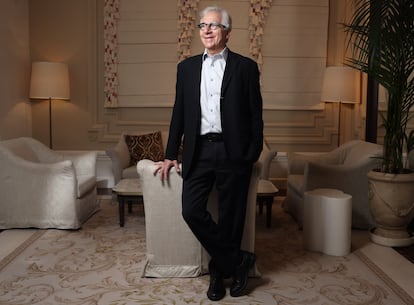Biologist Douglas Melton: ‘I was studying frogs until my son was diagnosed with diabetes — then I started looking for a cure’
The co-director of the Harvard Stem Cell Research Institute is researching a groundbreaking therapy that could free millions of people from insulin injections

Douglas Melton is on the verge of revolutionizing the world of type 1 diabetes. The biologist — who is co-director of the Harvard Stem Cell Research Institute — wants to alleviate the daily insulin injections endured by over nine million people. Unlike the lifestyle-related type 2 diabetes, type 1 has no known cause. Melton’s groundbreaking discoveries have earned him the prestigious Abarca Prize, an international medical sciences award presented by the HM Foundation at an awards ceremony on October 25 in Madrid.
Question. I understand you started researching diabetes because you have a son with the disease.
Answer. When my son Sam was just six months old, he was diagnosed with type 1. At the time, I knew nothing about this disease. Managing diabetes in a baby is challenging as it involves injecting insulin and monitoring blood sugar levels. It was my wife who suggested that, as a scientist, I should try and do something about it. I had been studying the development of frogs, but I decided to switch my focus to finding a cure for diabetes.
Q. Frogs?
A. I’ve been interested in them since I was little. I was researching how a frog egg knows how to develop into a frog — it’s a field called developmental biology.
Q. So you abandoned that line of research.
A. Yes, it’s what any parent would do. When something happens to your child, you try to fix it.
Q. How is Sam doing now?
A. Well, he’s studying at MIT [Massachusetts Institute of Technology] and has a degree in applied mathematics and physics.
Q. Is he still taking insulin?
A. Yes.
Q. How long will he have to keep doing that?
A. Good question, because when he reads about my research and sees me getting awards, he naturally wonders when he’ll benefit from all this.
Q. What’s your answer?
A. It’s closer than I expected — maybe a few years. Clinical trials are progressing well and show potential for a new medicine to help people with type 1 diabetes.
Q. Have you gotten patients participating in the clinical trials off insulin?
A. A couple of patients haven’t needed to inject insulin for a year. And the other patients are headed in the right direction — they need less and less insulin over time.
Q. How does your treatment work?
A. People with type 1 diabetes can’t produce insulin, a hormone necessary for converting food into energy. Without insulin, cells can’t absorb glucose properly. Therefore, insulin needs to be injected. But why inject insulin and measure blood sugar levels when the pancreas has cells that do both these tasks. They measure glucose and produce the necessary amount of insulin for the body. Our treatment aims to create insulin-producing cells, which the patient lacks, providing them with their own factory.
Q. Do we know why some people aren’t able to produce insulin?
A. We don’t, and the number of people with type 1 diabetes is growing — three million people now in North America and Europe. We know that isn’t caused by a single gene. But I don’t work in prevention. There are many diseases whose origin we still don’t understand, such as Alzheimer’s. I would like to know the causes, but in the meantime, what I want is a cure.
Q. What was the path that led you to this potential cure?
A. The concept is simple. We know certain cells are missing in type-1 patients, and we know certain stem cells can develop into any body part. The challenge was to determine how to instruct a cell to specialize in producing insulin, rather than bones, muscles or blood. Initially, I had no clue about the process and lacked any brilliant ideas. However, I persisted by studying the functioning of the pancreas and conducting experiments on mice based on that knowledge. If I were to start over now, progress would be much faster, since I did a lot of stupid tests that didn’t work.

Q. And how did the switch to a different line of research go? What doors did you knock on to leave frogs behind and start on diabetes?
A. I was very lucky, being a Harvard professor. I had excellent students and was able to obtain funding because of them. It wasn’t a solo project that I did in my garage. Over the years, at least 50 students have been involved in the research. So, it would be incorrect to say that I did this alone — there’s a whole team behind it.
Q. What’s next for you if the treatment is approved and becomes publicly available?
A. I haven’t thought about it much. The first thing I would probably do is treat my kids [Melton’s daughter also has diabetes]. And we would have a big party. Then I would think about a way to freeze the cells. For now, we have to administer live cells to the patient. It would be great if a doctor in Spain, for example, has access to frozen cells and can administer them directly to the patient.
Q. Would that make the treatment affordable? It seems like it would be expensive.
A. I’m not an economist, but I imagine the price will be high at first. Considering the large number of patients, the cost will decrease. It’s important to remember that this is a one-time expense, which can be a great value compared to the lifelong use of insulin. And like other advanced technologies, the price will drop over time after it first launches.
Q. Type 2 diabetes is a different disease with a different pharmacological treatment. Can cell replacement somehow benefit people with type 2?
A. Type 2 diabetes is related, but different. The body demands insulin, but cannot adequately respond. One reason may be that these patients do not have enough producer cells. If so, this type of treatment could be used. But I would like to stress that many people with type 2 diabetes can benefit from improving their diet and exercising. Somewhat selfishly, I don’t pay much attention this disease — I’m really focused on type 1. It’s all I think about as soon as I wake up. Just this morning I thought up a new experiment.
Q. Can you tell me what it is?
A. I want to use genetic modification so that cells are not rejected by the immune system. What happens is, our cells tell the body that the transferred cells are foreign and therefore a problem — so we need immunosuppressants to tolerate them. But think about a fetus inside a mother’s body. A fetus has cells from the father, so why doesn’t the mother’s body reject it? It’s an interesting question, and that’s what I was thinking about this morning.
Q. Does your research have implications for the treatment of other diseases?
A. There are several diseases — not many — that have to do with missing cells. The best example is Parkinson’s, when the cells in the central part of the brain that make dopamine fail. If you could convert a stem cell into one that makes dopamine and put it in the brain — which isn’t easy — it could be a cure.
Q. Looking to the more distant future — 30 or 40 years — what do you imagine can be achieved with stem cells?
A. Our body is constantly producing cells that become muscles, skin and blood. That’s why we don’t have a deficit a few weeks after donating blood. By that time, I think we’ll know how to stimulate cells so they regenerate. We take it for granted that aging is inevitable, but perhaps it isn’t. Maybe we can make it to 80 in perfect health thanks to tissue regeneration.
Q. Would this open the door to a type of immortality?
A. Possibly, but that’s not a very interesting goal. I don’t think anyone wants to be immortal. But healthy aging is a realistic goal. Anyone who has watched a parent or grandparent age knows how brutal the end of life can be.
Sign up for our weekly newsletter to get more English-language news coverage from EL PAÍS USA Edition
Tu suscripción se está usando en otro dispositivo
¿Quieres añadir otro usuario a tu suscripción?
Si continúas leyendo en este dispositivo, no se podrá leer en el otro.
FlechaTu suscripción se está usando en otro dispositivo y solo puedes acceder a EL PAÍS desde un dispositivo a la vez.
Si quieres compartir tu cuenta, cambia tu suscripción a la modalidad Premium, así podrás añadir otro usuario. Cada uno accederá con su propia cuenta de email, lo que os permitirá personalizar vuestra experiencia en EL PAÍS.
¿Tienes una suscripción de empresa? Accede aquí para contratar más cuentas.
En el caso de no saber quién está usando tu cuenta, te recomendamos cambiar tu contraseña aquí.
Si decides continuar compartiendo tu cuenta, este mensaje se mostrará en tu dispositivo y en el de la otra persona que está usando tu cuenta de forma indefinida, afectando a tu experiencia de lectura. Puedes consultar aquí los términos y condiciones de la suscripción digital.
More information
Archived In
Últimas noticias
Most viewed
- Oona Chaplin: ‘I told James Cameron that I was living in a treehouse and starting a permaculture project with a friend’
- Sinaloa Cartel war is taking its toll on Los Chapitos
- Reinhard Genzel, Nobel laureate in physics: ‘One-minute videos will never give you the truth’
- Why the price of coffee has skyrocketed: from Brazilian plantations to specialty coffee houses
- Silver prices are going crazy: This is what’s fueling the rally











































